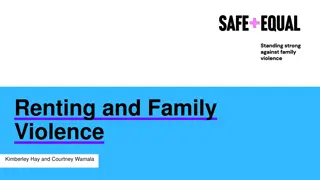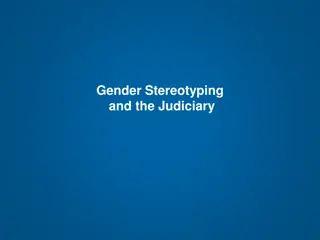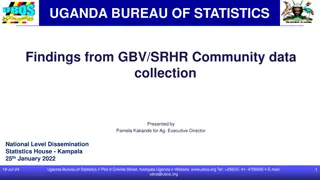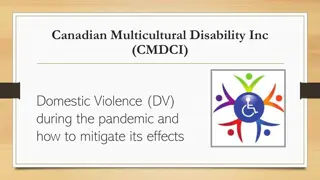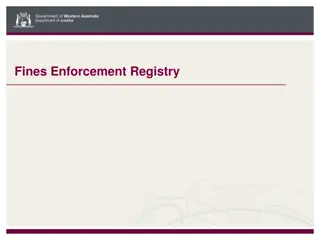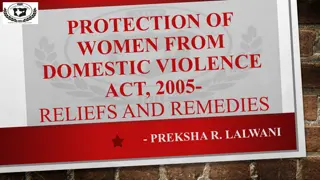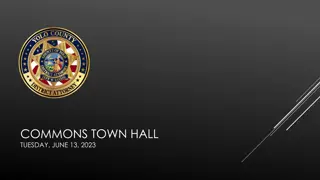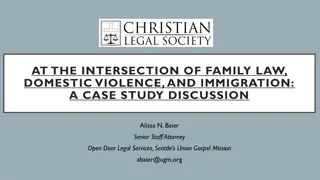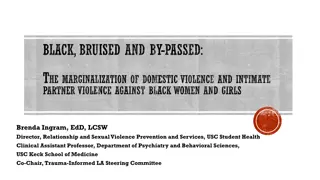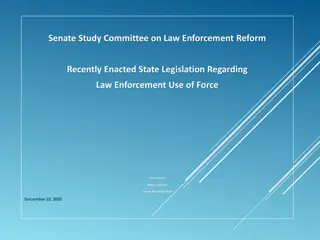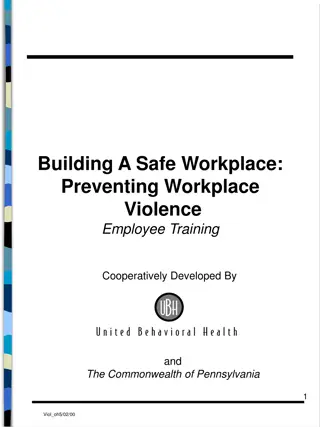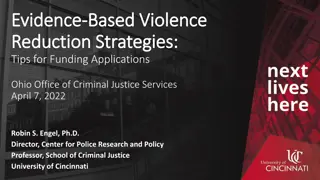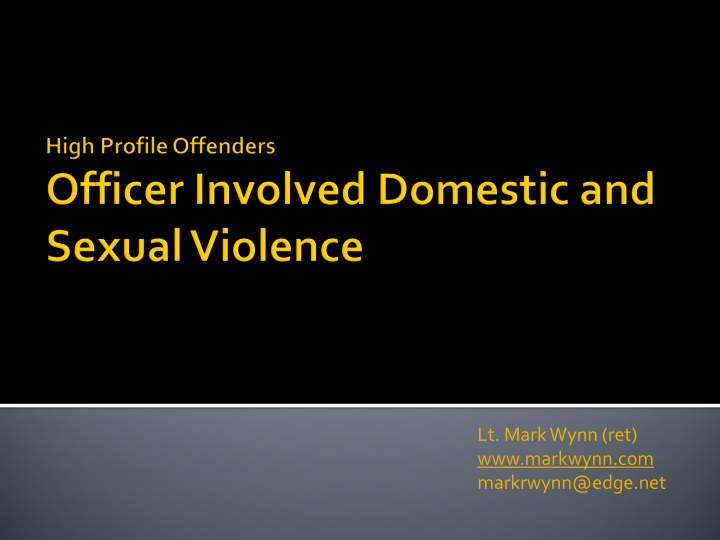
Officer-Perpetrated Domestic Violence and Challenges in Law Enforcement
Explore the complexity of officer-perpetrated domestic violence, the role of policy in addressing it, common abusive tactics, and the impact on agency mission and public confidence. Learn about a case of cyberstalking by a former law enforcement officer and the challenges faced by victims within law enforcement.
Download Presentation

Please find below an Image/Link to download the presentation.
The content on the website is provided AS IS for your information and personal use only. It may not be sold, licensed, or shared on other websites without obtaining consent from the author. If you encounter any issues during the download, it is possible that the publisher has removed the file from their server.
You are allowed to download the files provided on this website for personal or commercial use, subject to the condition that they are used lawfully. All files are the property of their respective owners.
The content on the website is provided AS IS for your information and personal use only. It may not be sold, licensed, or shared on other websites without obtaining consent from the author.
E N D
Presentation Transcript
Lt. Mark Wynn (ret) www.markwynn.com markrwynn@edge.net
Acknowledge the complexity and challenges posed by officer perpetrated domestic violence Appreciate the function of policy to establish agency expectations and standards The common tactics of abusive officers and the intersections with law enforcement training and culture
Unique dangers Threatens agency mission and morale High liability risk Impacts public confidence Questions integrity of the agency Is there a culture? There must be a swift, sure and effective intervention standoff
COLUMBUS, Ohio William P. Elschlager, 49, of Marietta, Ohio, was sentenced in U.S. District Court to 24 months in prison, three years of supervised release and ordered to pay a $2,500 fine for cyberstalking. Elschlager was employed with the Ohio State Highway Patrol for 19 years and served as post commander for the Marietta Post. He was employed in law enforcement, in total, for 25 years. He used location information from GPS tracking, in conjunction with his law enforcement status, to relentlessly stalk and intimidate his victim, U.S. Attorney Glassman said. Elschlager s position and experience as a law enforcement officer for 25 years makes the offense especially heinous. His actions stripped his victim of a sense of security and safety. Those actions warrant time spent in prison. 6
A female officer who lives with domestic violence fears people will question how she can protect others if she can't protect herself. She has to choose between jeopardizing her safety by reporting, or possibly violating department policy by remaining silent. Making a complaint against a police officer is a dangerous act, especially when the complainant is herself an officer. Her abuser can call on his personalandprofessional network for support and defense against any allegations. Cooperation between advocates and police can be beneficial to both parties and to many civilian victims, but it presents complex problems when the alleged perpetrator or victim is a police officer. Diane Wetendorf, Inc.
Arrest avoidance and mediation Cooling down Walk around the block Ineffective or no training at all Recruit - In-service - Specialized 70
Lack of policies addressing domestic violence for the general public Officer discretion led to inaction and civil liability Criminal codes did not define domestic violence
Officers rarely receive counseling/training on avoiding physical conflict within their relationships or marriage Psychological services for officers is often not available
No or ineffective screening for domestic/sexual violence history in recruitment are they batterers when they are hired on or does it happen because of the job? what kind of people do we hire as police officers? does psychological testing weed them out? phoenix
The law enforcement community is a closed one Lack of leadership within a department or local government on the issue of domestic violence A combination of these things may have set the stage for a failure to protect the general public and the police family phoenix
Chief Anthony Bouza of Minneapolis once a commander in the New York Police Department, wrote in his memoir Police Unbound, The Mafia never enforced its code of blood-sworn omerta with the ferocity, efficacy, and enthusiasm the police bring to the Blue Code of Silence. 13
Between 1990 and 1997, Los Angeles Police Department investigated 227 cases of alleged OIDV, of which 91 were sustained; of the 91 sustained by the department, only four resulted in a criminal conviction. 14
Only 7 percent of Canadian cops convicted of domestic violence received a prison sentence, versus 49 percent of civilians convicted of comparable crimes, according to a study of Canadian cases from 2000 to 2014. Danielle Sutton, News Coverage of Officer-Involved Domestic Violence (OIDV): A Comparative Content Analysis (MA thesis, University of Guelph, 2015), accessed December 15, 2015, https://atrium.lib.uoguelph.ca/xmlui/bitstream/handle/10214/9099/Sutton_Danielle_201508_MA.pdf?sequence=1. 15
If police experience domestic violence at the same rate as the general public, studies estimate that 60,000 to 180,000 law enforcement families would be affected by domestic violence annually (Waters and Ussery, 2007). Experts (Waters and Ussery, 2007; 16
Seventy-three percent of male cops who admitted being violent toward their spouse also admitted they had been violent toward citizens, according to Arizona State University sociologist Leanor Johnson (2000). 17 The Secret Epidemic of Police Domestic Violence: How It Affects Us All The Domestic Violence Report 2015 - By Alex Roslin*
In 2000 survey of 210 law enforcement officers it was discovered that 54% of officers admitted they knew of officers involved in domestic violence, 16% knew of incidents of unreported OIDV, 31% knew of members in their department who had been disciplined for OIDV, and 55% claimed intervention and prevention programs would be helpful. 18 Ryan 2000
Data obtained from 299 officers in 27 states, found more than half (51.3%) reported they had been called to respond to a domestic violence incident which involved another law enforcement officer. Russell and Tannenbaum (2016) 19
Analyzes of news articles between 2005 and 2011 found 6,724 arrests involving more than 5,500 officers. Sex-related cases were the third-most common, behind violence and profit-motivated crimes. Cato Institute reports released in 2009 and 2010 found sex misconduct the No. 2 complaint against officers, behind excessive force. Phil Stinson, Bowling Green State University
Keeping the secret of domestic violence within the family makes it worse by preventing early intervention to save the officer and prolongs the violence increasing the chances of injury, murder and suicide.
We are taught to: control our emotions discipline our minds to remain focused in dynamic situations to prevail in the face of adversity to interrogate when suspicious to intimidate or match aggression when challenged
We are taught to: to dominate when threatened command presence, surveillance control through pain without visible injury Carotid restraint, wristlocks, arm holds, use of handcuffs be an authority figure within the community to use firearms, trained in confrontation Add to this .. exceptional pressures of police work being prone to alcoholism and divorce
shift work and court time unfair publicity consistent exposure to pain and suffering Add to this .. violent behavior learned as a child
Is there a Code of Silence? we are good at keeping secrets we are fraternalistic we build bonds stemming from life and death situations on the street DO WE BREAK THIS CODE?
Physical VIOLENCE Sexual USING USING COERCION AND THREATS Will the offender/officer use power and control against the responding officer? INTIMIDATION USING ECONOMIC ABUSE USING EMOTIONAL ABUSE POWER AND CONTROL USING ISOLATION USING MALE PRIVILEGE MINIMIZING DENYING AND BLAMING USING CHILDREN Physical VIOLENCE Sexual
Intimidation Victim knows war stories Victim knows what he has done in the field He knows the criminal justice system DA, Judges Officer has more credibility in court Victim won t be believed Officer /suspect appears in court in uniform Taz Other officers coming to court to show support under 4/12/2025
Emotional Abuse Expert at control tactics Threatens suicide if he/she cost them their job
Isolation Only socialize with law enforcement Loss of law enforcement family social circle 4/12/2025
Economic abuse.. Loss of job, money, pension He controls the money I m the bread winner .. I see you are married. How would like it ? 4/12/2025
Using Male Privilege/Officer Privilege Command presence Access to criminal files Officers testify against her Her word against his 4/12/2025
Coercion and threats of greater harm.. Control/pain without visible injury Coercion and threat by others in department Stalking by other officer(s) Pressure from police wives 4/12/2025
Minimizing - Denying - Blaming.. Stress of the job It s because of all I see and deal with Other officers will do this for the suspect They ve all heard about her Supervisor buys into it 4/12/2025
Using the Children Threats to take children Use children for surveillance 4/12/2025
It is imperative to the protection of citizens civil rights and the trust communities place in law enforcement that policies be adopted as part of a clear statement that sexual misconduct will not be tolerated. Chief David Nye, Fredericksburg Police Department, VA
Phil Stinson, a researcher at Bowling Green State University, analyzed news articles between 2005 and 2011 and found 6,724 arrests involving more than 5,500 officers. Sex-related cases were the third-most common, behind violence and profit- motivated crimes. Cato Institute reports released in 2009 and 2010 found sex misconduct the No. 2 complaint against officers, behind excessive force.
He didnt choose CEOs or soccer moms. He chose women he could count on not telling. Prosecutor Lori McConnell
Holtzclaw chose victims for their perceived vulnerability and lack of credibility Found to have assaulted 13 black women, most of whom were low income and some who were using alcohol/drugs, and who had prior convictions. December 20, 2013 first known sexual assault May 8, 2014 Oklahoma City Police began investigating Holtzclaw for sexual assault. Assaulted 5 more women while still on-duty June 18, 2014 - Jannie Ligons who did not meet the profile of his other victims was assaulted by Holtzclaw and reported the assault December 9, 2015 - Convicted of sexual assault for 8 of the 13 victims. Sentenced to 263 years in prison.
Provides guidance Ensures full investigation Impact on Agency and community Polarization of departments members Media and public image Addresses liability
Failure to take proper actions to protect Failure to appropriately enforce a court order protecting a victim of domestic violence Failure to respond at all or in a timely manner Failure to provide information to a victim as required by law Arresting a citizen without establishing probable cause Exhibiting a pattern of differential treatment or application of the law to domestic violence cases
Prevention Education and Training Early Warning and Intervention Incident Response Protocol Victim Safety Post-Incident Administrative and Criminal Decisions
INCIDENTS INVOLVING POLICE OFFICERS In developing the procedures and steps to be followed when a domestic violence occurrence involves a member of a police service, any procedure should, in addition to the general procedures involved in non-member incidents, reflect: victim safety; objectivity; accountability; confidentiality; and lack of bias towards the member. tradition
Provide training to supervisory personnel on early warning signs Select lethality assessment tool Draft and commit to MOUs with neighboring departments and advocacy agencies Provide outreach to families of department personnel Prepare victim assistance resources
The Peace Officer Certification Information System (POCIS) was established to reduce the interstate rehiring of law enforcement officers decertified for misconduct by U.S. Peace Officer Standards and Training (POST) Boards and Commissions. This system provides general information regarding state policies and guidelines as well as access to the searchable National Decertification Index (NDI) by approved law enforcement hiring entities. www.iadlest.org 410-875-3606
Firm, written policies with sanctions for all levels of the department Better screening for recruits One step up investigations of DV incidents Speed the investigations EARLY INTERVENTION
Mandatory reporting Immediate response investigation by specialized investigators Lethality/danger - suicide assessments Notification up the chain Speedy and thorough investigation
Counseling Dis-empowerment Discipline Dismissal Prosecution

